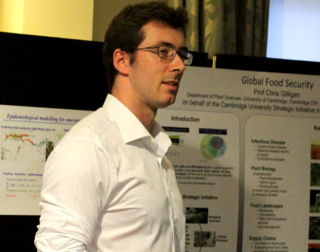Case Study: Remote Lecturing
Conducting interactive STEM teaching online
Dr Matt Castle

Like many other lecturers during the emergency transition to online teaching and learning, Dr Matt Castle has been busy adapting his course material. Matt teaches across the spectrum of undergraduates, postgraduates and research staff, and leads the Graduate School of Life Sciences Biostatistics Initiative, which is responsible for the delivery and coordination of biostatistics training for all research staff and graduate students working in the life sciences at the University of Cambridge. We spoke to Matt about his experiences and lessons learned from transitioning online.
Article also available as downloadable PDF
What was your first experience of transitioning teaching online?
Matt was delivering a statistics course to postgraduate students at the end of Lent Term, which needed to transition online partway through. The series consisted of six teaching sessions, each comprising a one-hour lecture followed by a computer practical, for 30-40 people. In these practicals, students work through problems to develop a set of skills. He noted that even though the students work independently, they are likely to run into problems, so being able to offer immediate feedback is essential in allowing them to continue progressing. He wanted to explore ways to offer that support and feedback in a virtual environment.
Matt decided to give a one-hour 'live-cast' lecture, followed by an interactive practical where he could check in and offer support virtually. He tried out various platforms to explore different functionalities; University Information Services currently recommend and offer guidance on Panopto and Google Meet for live-cast lectures.
What was initially involved in terms of logistics, time or resources?
Matt decided to deliver the lecture live to maintain interactivity with his audience, and so that they could talk through some of the problems as a group before taking a tea break and working through the tasks independently. To make sure nobody missed out as a result of connectivity, caring responsibilities or time zone issues, he also recorded the lectures so that they were accessible afterwards.
He contacted his students in advance to check that the proposed approach and software would work for everyone, and checked in at the beginning and end of every session about what was and wasn't working. He found they were not only very supportive, but also patient and forgiving, allowing him the freedom to try out different pedagogical strategies and software to compare their effectiveness.
Matt described how during the practical session, he reached out individually to each of the 30 participants to check in on their progress. If they were stuck, he would ask them to share their screen so that he could see which part of the problem they were struggling with. He would simultaneously keep his eye on the chat function so that he could reply promptly if anyone had questions or needed urgent help.
Listen to Matt talk about this in more detail
What lessons did you learn?
Trial the software (far) in advance
Matt emphasised the value of doing a trial run with a family member, flatmate or even just yourself on a different device, to check what you can see as a host, and what someone else sees as a participant. Matt explained that he encouraged his participants at the start to engage and just try out the available features such as text-based chat, and he emphasised the value of being honest with his students about how new he was to this style of teaching.
Engage students by finding subtle ways for interactivity
Matt found that he really missed the non-verbal cues and responses while teaching: the nodding, the eye contact and the laughs (or eye-rolls) at his jokes. He explained that by encouraging his audience to post emojis in the chat, not only could he see whether people had understood and were following, but it also kept people engaged. He noted that whenever he got a sign of life from his audience, he realised just how much he had missed reading the non-verbal cues and what a difference it made to engagement and his own teaching.


Check in with your audience about the pace
Matt was surprised to find that he kept going over time in the lecture portion of the sessions, something which hadn't been an issue in the face-to-face lectures. Discussing online lectures and videos with some of his undergraduates, they explained that they watched most of these videos at double speed, as they had been recorded at too slow a pace. Matt emphasised the value of checking in with your audience about the pace if you are doing a live-cast and adjusting accordingly, as this will improve the quality both live and in the recording.
Design online content and delivery with accessibility foregrounded
Matt emphasised the value of integrating accessibility features that would support all learners from the beginning (of the transition or the design phase), rather than adding them as an afterthought or in a last-minute panic. For example, if you are comfortable doing so, deliver the lecture with a video of yourself in parallel with the PowerPoint, as this may be more engaging for some - but ensure students can download and focus on just the slides if they find it distracting to have two elements to watch. Alternatively, suggest to your learners that they can stick a post-it over the video if they need to concentrate more on the slides.
Top Tips!
- Get in touch with students in advance to outline what will happen, and to make sure both you and they are set up with right tools.
- Ask for feedback during and after the teaching session. Don't be afraid to be honest if it's not perfect as both you and your students get used to new ways of working.
- Seek new means to interact with your audience and find ways to encourage laughter, questions, feedback and interaction: look for ways to recreate what you really enjoy about lecturing face-to-face.
- Have clear back-up plans in case of connectivity issues during an interactive session (whether on your end or your students'), such as recording the session.
- Share your experiences with colleagues in your departments and colleges so that you can learn from each other.
Author

Dr Juliet Scott-Barrett is a Project Associate here at the Centre for Teaching and Learning, with a focus on inclusive practices. She contributes to the scholarly basis of the CCTL work programme, carrying out research which addresses priority themes and questions.
Cambridge Teaching & Learning Newsletter vol. 1 (issue 4) April 2020
